Abstract
BACKGROUND: The purpose of this study was to identify factors on which European general practitioners (GPs) base their decisions to admit to hospital patients with lower respiratory tract infections (LRTI). METHODS: A survey was carried out from December 1993 to January 1994 to identify factors that affect GPs' decisions to admit to hospital patients with LRTI by collecting data on 2056 patients from 605 GPs in France, Germany, Italy, Spain, and the UK. RESULTS: Only 93 (4.5%) of the patients included in the study were admitted to hospital. Univariate analysis showed that age > 60 years, institutionalisation of the patient, concomitant diseases, cardiac insufficiency, asthma, a diagnosis of pneumonia, and clinical signs such as chest pain, cyanosis, tachypnoea and hypotension significantly (odds ratio (OR) > 2.0, p < 0.002) influenced the decision to admit to hospital. No influence could be shown for sex, smoking habits, history of bronchiectasis or chronic bronchitis, the presence of fever, chills, myalgia, cough or purulent sputum, and the diagnoses of acute bronchitis, influenza or exacerbation of chronic bronchitis. In the multivariate analysis only the presence of chest pain (OR 2.3, 95% confidence interval (CI) 1.5 to 3.5), cyanosis (OR 4.1, 95% CI 2.4 to 7.1), dyspnoea (OR 4.9, 95% CI 3.1 to 7.9), and hypotension (OR 2.9, 95% CI 1.6 to 5.2), as well as a diagnosis of pneumonia (OR 6.6, 95% CI 4.3 to 10) (all p < 0.00001) remained as factors that significantly affected the decision to admit to hospital. CONCLUSIONS: Clinical signs of severe infection and a diagnosis of pneumonia are the main factors that induce GPs to admit patients with LRTI to hospital in Europe.
Full text
PDF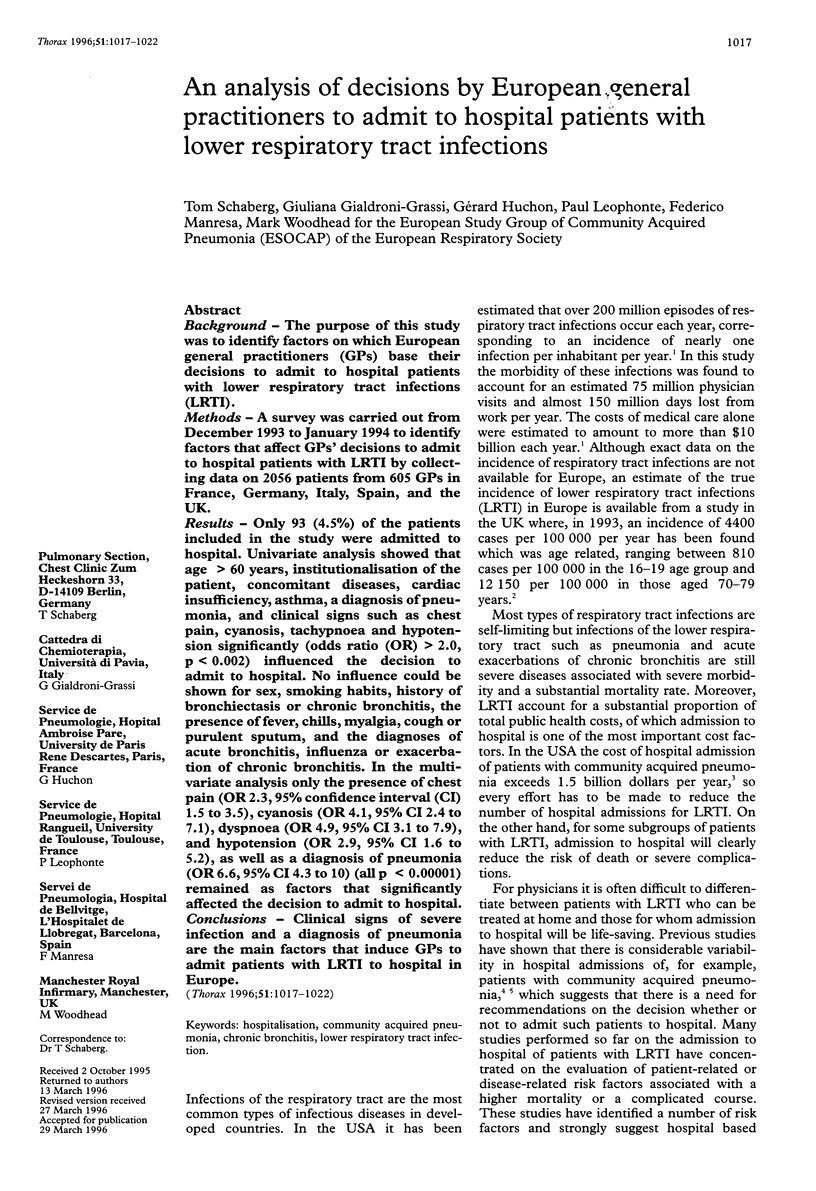
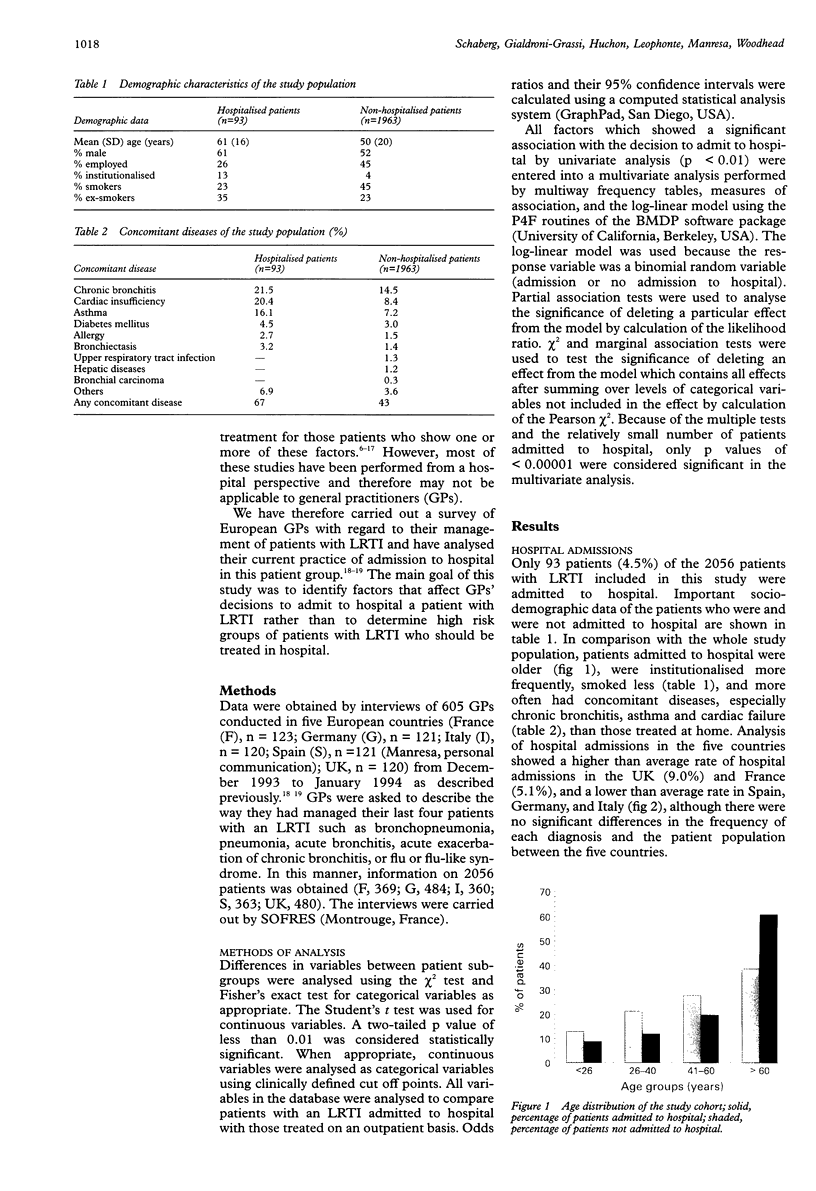
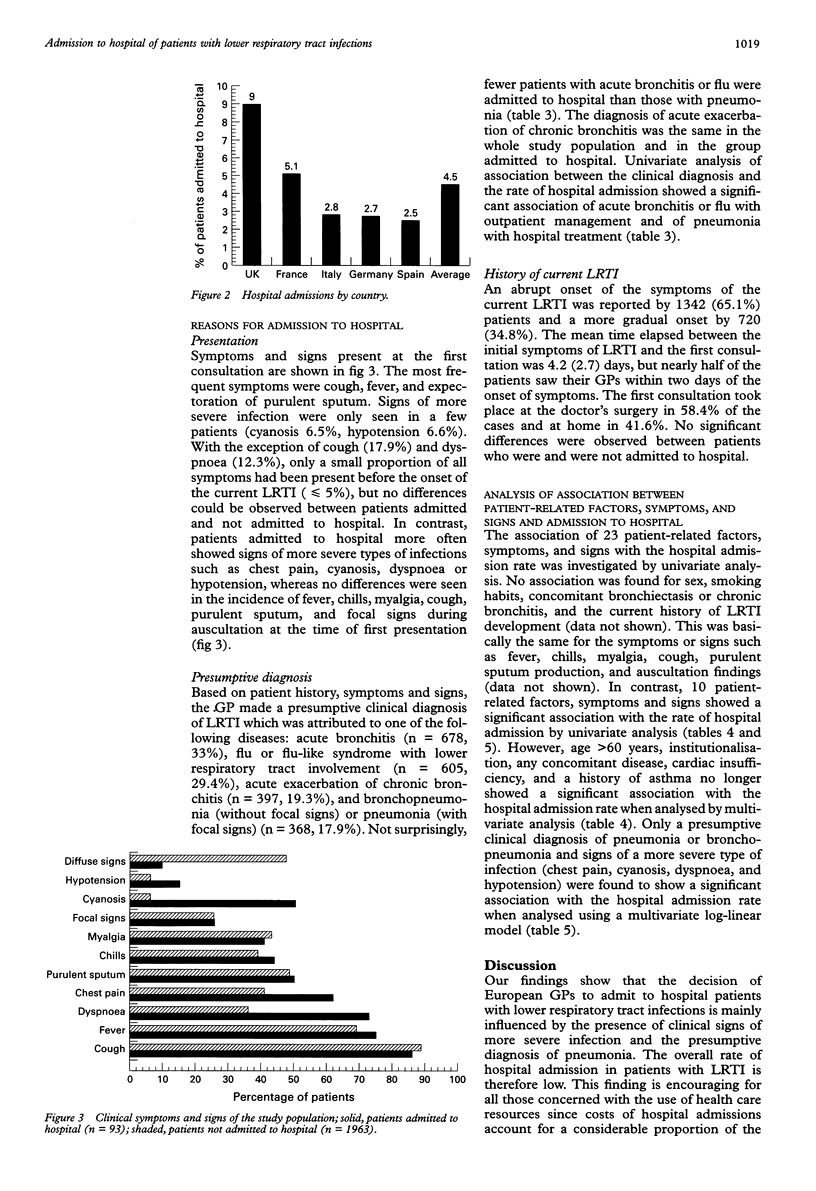
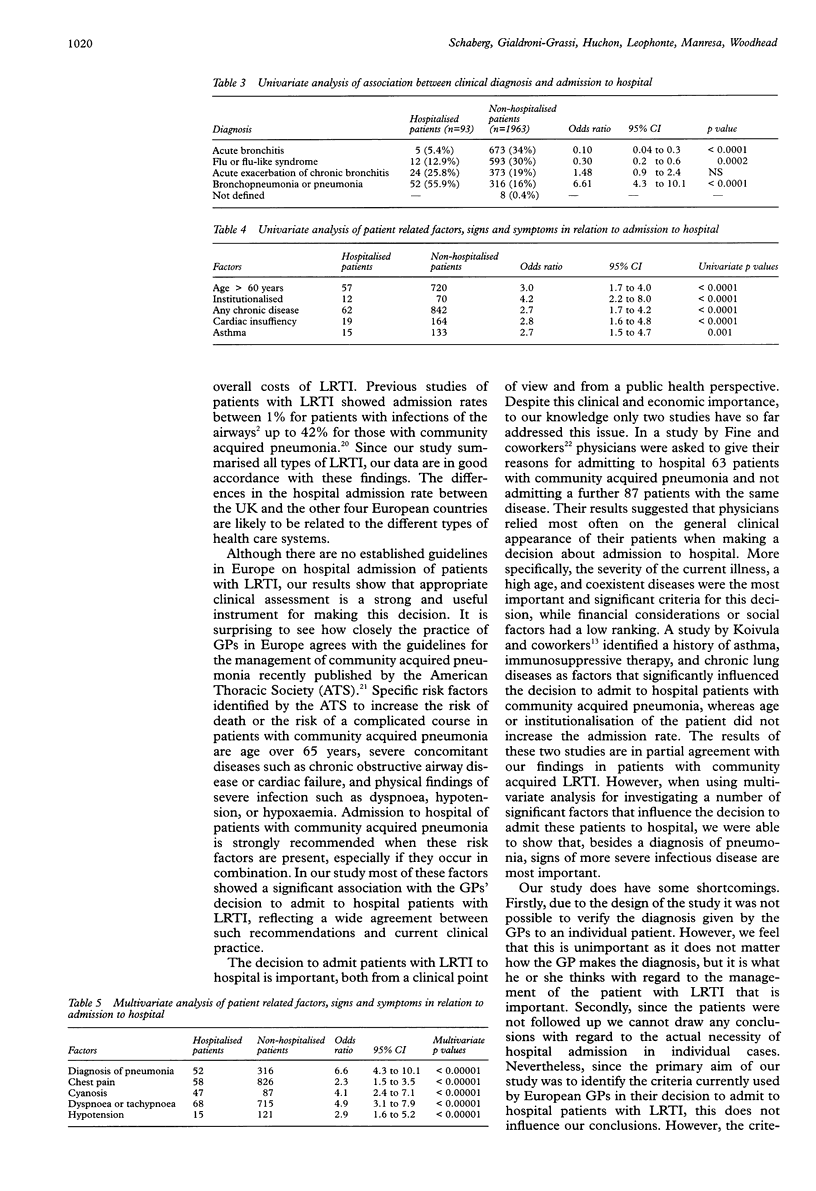
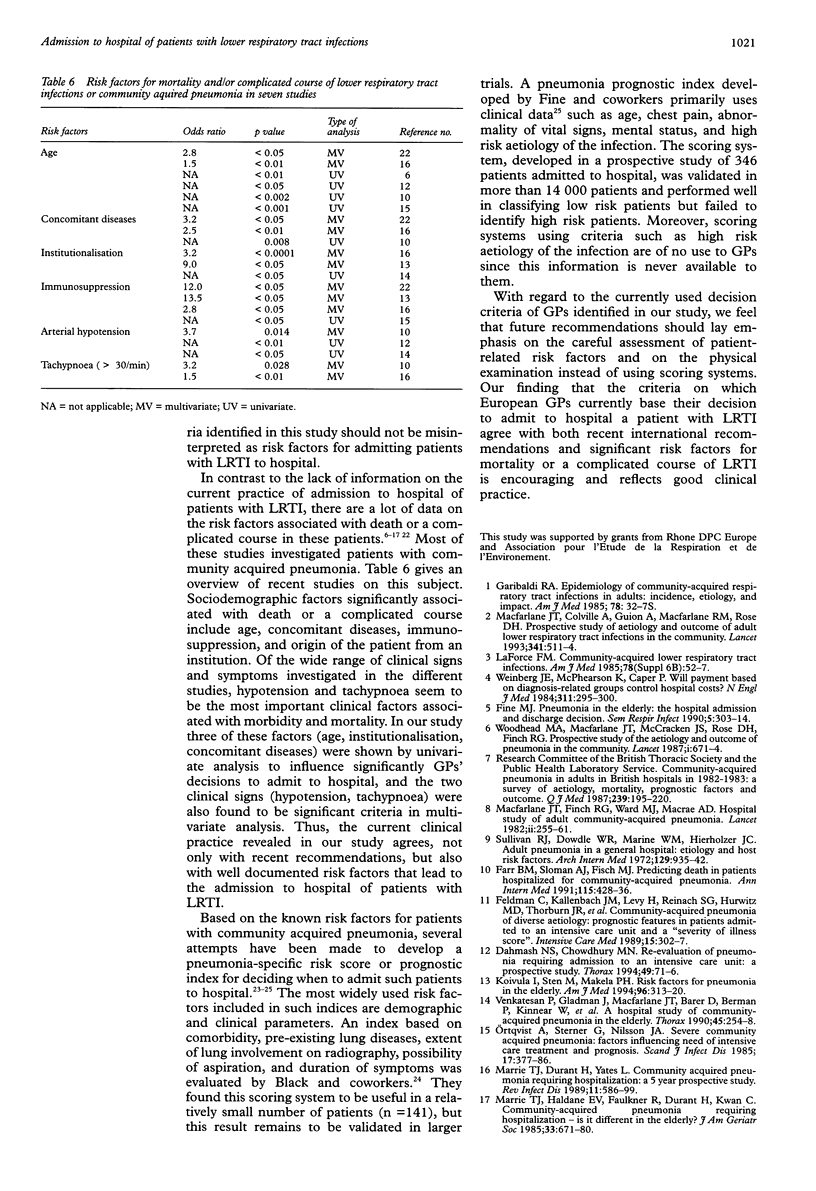

Images in this article
Selected References
These references are in PubMed. This may not be the complete list of references from this article.
- Dahmash N. S., Chowdhury M. N. Re-evaluation of pneumonia requiring admission to an intensive care unit: a prospective study. Thorax. 1994 Jan;49(1):71–76. doi: 10.1136/thx.49.1.71. [DOI] [PMC free article] [PubMed] [Google Scholar]
- Farr B. M., Sloman A. J., Fisch M. J. Predicting death in patients hospitalized for community-acquired pneumonia. Ann Intern Med. 1991 Sep 15;115(6):428–436. doi: 10.7326/0003-4819-115-6-428. [DOI] [PubMed] [Google Scholar]
- Feldman C., Kallenbach J. M., Levy H., Reinach S. G., Hurwitz M. D., Thorburn J. R., Koornhof H. J. Community-acquired pneumonia of diverse aetiology: prognostic features in patients admitted to an intensive care unit and a "severity of illness" core. Intensive Care Med. 1989;15(5):302–307. doi: 10.1007/BF00263865. [DOI] [PubMed] [Google Scholar]
- Fine M. J. Pneumonia in the elderly: the hospital admission and discharge decisions. Semin Respir Infect. 1990 Dec;5(4):303–313. [PubMed] [Google Scholar]
- Fine M. J., Singer D. E., Hanusa B. H., Lave J. R., Kapoor W. N. Validation of a pneumonia prognostic index using the MedisGroups Comparative Hospital Database. Am J Med. 1993 Feb;94(2):153–159. doi: 10.1016/0002-9343(93)90177-q. [DOI] [PubMed] [Google Scholar]
- Fine M. J., Smith D. N., Singer D. E. Hospitalization decision in patients with community-acquired pneumonia: a prospective cohort study. Am J Med. 1990 Dec;89(6):713–721. doi: 10.1016/0002-9343(90)90211-u. [DOI] [PubMed] [Google Scholar]
- Garibaldi R. A. Epidemiology of community-acquired respiratory tract infections in adults. Incidence, etiology, and impact. Am J Med. 1985 Jun 28;78(6B):32–37. doi: 10.1016/0002-9343(85)90361-4. [DOI] [PMC free article] [PubMed] [Google Scholar]
- Jokinen C., Heiskanen L., Juvonen H., Kallinen S., Karkola K., Korppi M., Kurki S., Rönnberg P. R., Seppä A., Soimakallio S. Incidence of community-acquired pneumonia in the population of four municipalities in eastern Finland. Am J Epidemiol. 1993 May 1;137(9):977–988. doi: 10.1093/oxfordjournals.aje.a116770. [DOI] [PubMed] [Google Scholar]
- Karalus N. C., Cursons R. T., Leng R. A., Mahood C. B., Rothwell R. P., Hancock B., Cepulis S., Wawatai M., Coleman L. Community acquired pneumonia: aetiology and prognostic index evaluation. Thorax. 1991 Jun;46(6):413–418. doi: 10.1136/thx.46.6.413. [DOI] [PMC free article] [PubMed] [Google Scholar]
- Koivula I., Sten M., Mäkelä P. H. Risk factors for pneumonia in the elderly. Am J Med. 1994 Apr;96(4):313–320. doi: 10.1016/0002-9343(94)90060-4. [DOI] [PubMed] [Google Scholar]
- La Force F. M. Community-acquired lower respiratory tract infections. Prevention and cost-control strategies. Am J Med. 1985 Jun 28;78(6B):52–57. doi: 10.1016/0002-9343(85)90364-x. [DOI] [PubMed] [Google Scholar]
- Macfarlane J. T., Colville A., Guion A., Macfarlane R. M., Rose D. H. Prospective study of aetiology and outcome of adult lower-respiratory-tract infections in the community. Lancet. 1993 Feb 27;341(8844):511–514. doi: 10.1016/0140-6736(93)90275-l. [DOI] [PubMed] [Google Scholar]
- Macfarlane J. T., Finch R. G., Ward M. J., Macrae A. D. Hospital study of adult community-acquired pneumonia. Lancet. 1982 Jul 31;2(8292):255–258. doi: 10.1016/s0140-6736(82)90334-8. [DOI] [PubMed] [Google Scholar]
- Marrie T. J., Durant H., Yates L. Community-acquired pneumonia requiring hospitalization: 5-year prospective study. Rev Infect Dis. 1989 Jul-Aug;11(4):586–599. doi: 10.1093/clinids/11.4.586. [DOI] [PubMed] [Google Scholar]
- Marrie T. J., Haldane E. V., Faulkner R. S., Durant H., Kwan C. Community-acquired pneumonia requiring hospitalization. Is it different in the elderly? J Am Geriatr Soc. 1985 Oct;33(10):671–680. doi: 10.1111/j.1532-5415.1985.tb01775.x. [DOI] [PubMed] [Google Scholar]
- Ortqvist A., Sterner G., Nilsson J. A. Severe community-acquired pneumonia: factors influencing need of intensive care treatment and prognosis. Scand J Infect Dis. 1985;17(4):377–386. doi: 10.3109/13813458509058778. [DOI] [PubMed] [Google Scholar]
- Sullivan R. J., Jr, Dowdle W. R., Marine W. M., Hierholzer J. C. Adult pneumonia in a general hospital. Etiology and host risk factors. Arch Intern Med. 1972 Jun;129(6):935–942. [PubMed] [Google Scholar]
- Venkatesan P., Gladman J., Macfarlane J. T., Barer D., Berman P., Kinnear W., Finch R. G. A hospital study of community acquired pneumonia in the elderly. Thorax. 1990 Apr;45(4):254–258. doi: 10.1136/thx.45.4.254. [DOI] [PMC free article] [PubMed] [Google Scholar]
- Wennberg J. E., McPherson K., Caper P. Will payment based on diagnosis-related groups control hospital costs? N Engl J Med. 1984 Aug 2;311(5):295–300. doi: 10.1056/NEJM198408023110505. [DOI] [PubMed] [Google Scholar]
- Woodhead M. A., Macfarlane J. T., McCracken J. S., Rose D. H., Finch R. G. Prospective study of the aetiology and outcome of pneumonia in the community. Lancet. 1987 Mar 21;1(8534):671–674. doi: 10.1016/s0140-6736(87)90430-2. [DOI] [PubMed] [Google Scholar]



